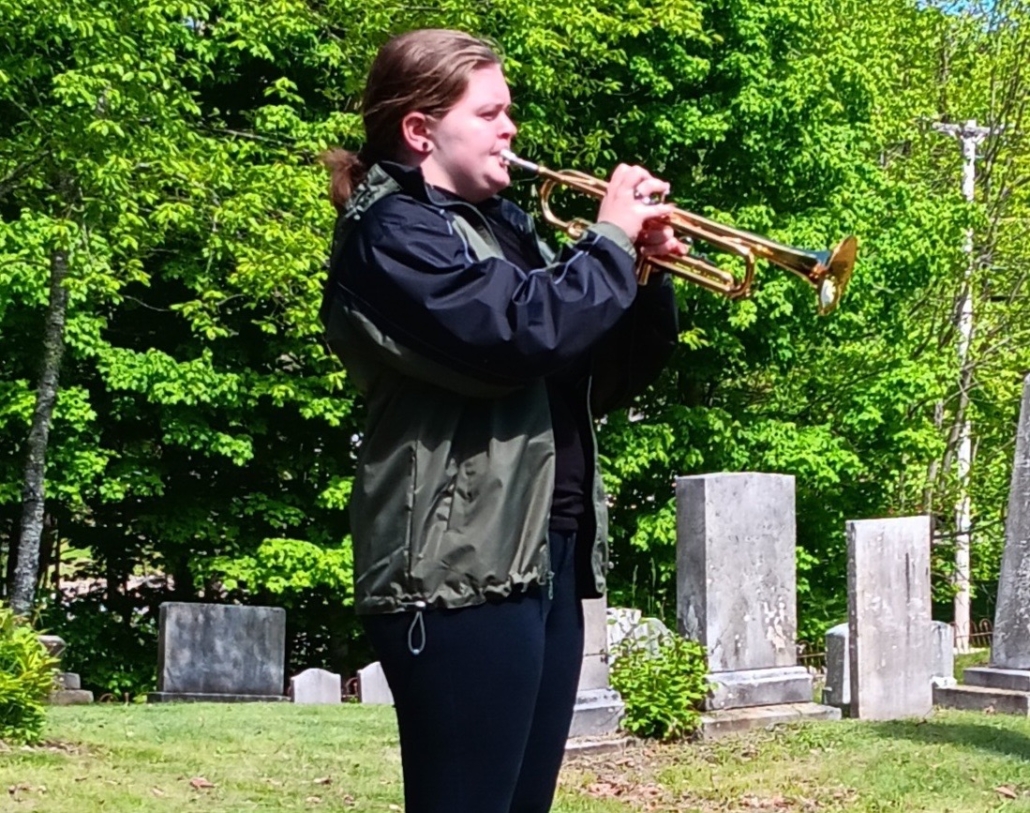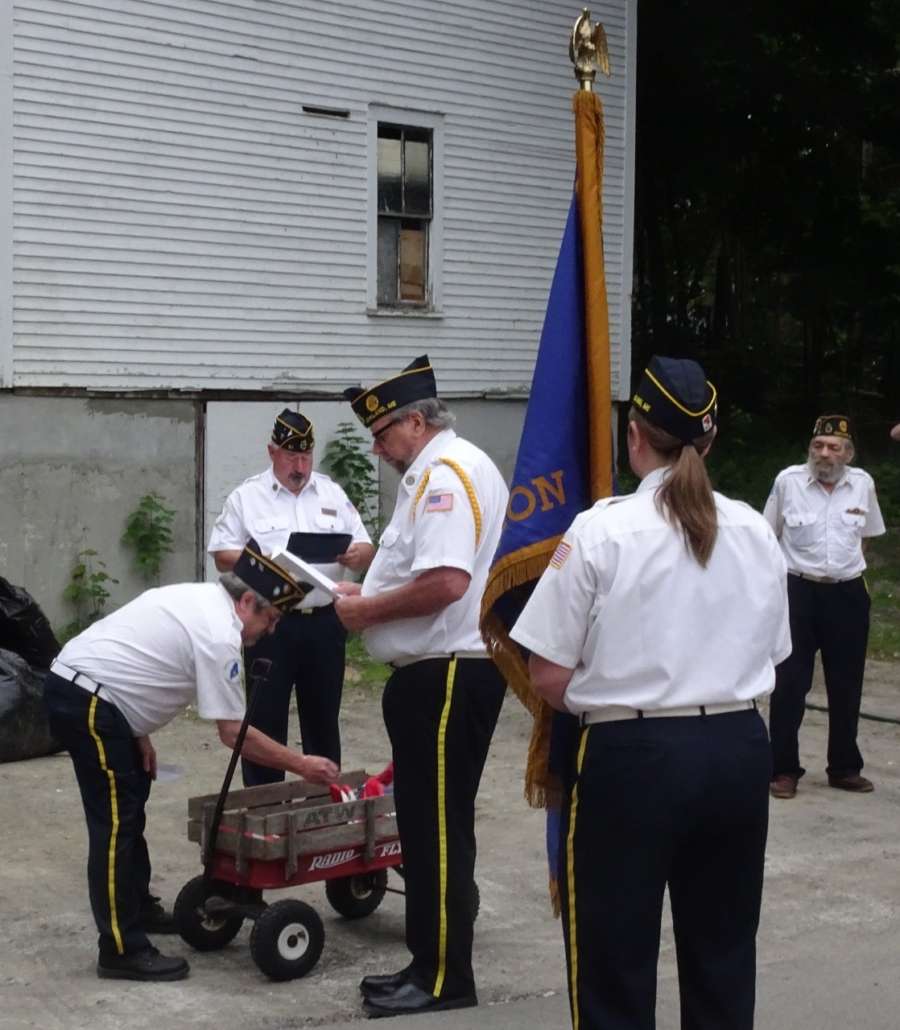Inaugural Thanksgiving dinner at SCCC well attended
/0 Comments/in China, Community, Holidays, South China/by Jayne Winters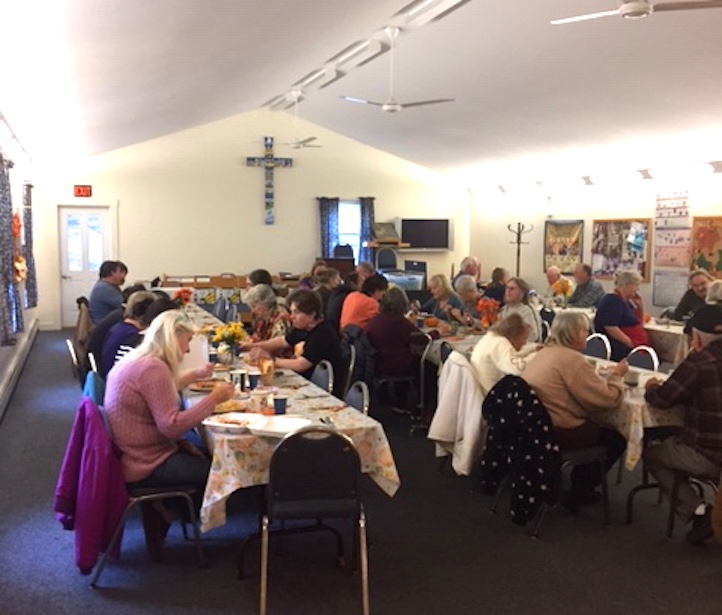
South China Community Church (SCCC) served about 55 people at its first free Community Thanksgiving Dinner on November 28. Photo by Jayne Winters
by Jayne Winters
South China Community Church (SCCC) served about 55 people at its first free Community Thanksgiving Dinner on November 28. While SCCC is known for its monthly Blessed Breakfasts and various dinner and soup fundraisers throughout the year, this was the first time its members provided a holiday meal.
The idea was discussed at the September Church Council meeting after a new Sunday service attendee asked if SCCC offered Thanksgiving dinner for people who are alone on the holiday, away from family or simply don’t have the energy or means to make dinner for their small families. Council members voted unanimously to do it and with Debbie Stowe taking the lead, church members enthusiastically got busy!
Dining room set-up and food preparations began Wednesday morning; kitchen workers returned early Thursday to finish cooking, carving, setting tables, slicing pies, etc. Following Pastor Paul Harwath’s opening prayer, folks thoroughly enjoyed their meal. The menu included turkey, ham, stuffing, gravy, mashed potato, squash, pearl onions and other veggies, as well as cranberry sauces, homemade rolls, ambrosia, cucumber salad, corn bread, homemade pies and beverages. In addition to the wonderful cooks, there were food and beverage servers, clean-up crews, and, of course, dishwashers!
Many thanks to everyone who helped make this dinner such a success. Donations of food and gift certificates came from Hannaford, Tobey’s, Sam’s Club, Shaw’s, Walmart, and countless church and community members. A free will offering that totaled $236 will be used to help purchase gifts for three families SCCC is sponsoring this Christmas – thank you so much for your generosity!
SCCC’s first Thanksgiving dinner went very well and the church plans to do it again next year. Leftovers were taken to the Bread of Life Ministries, in Augusta, for distribution to two local food pantries. We have much to be thankful for, indeed.
POETRY CORNER: Holiday Nights
/0 Comments/in Holidays, Poems/by Website Editor
Holiday Nights
Written by Connie Hartley
The sky is filled with beautiful lights
Sparkling brightly through the night
Holiday music fills the air
Love and happiness everywhere
Horse and sleigh are ready to carry
Happy couples singing merrily
Through the snow-covered hills
Snuggled together so not to be chilled
There is a special feeling that fills the air
One that leaves you without a care
Signs of blessings all around
As family and friends gather in the town
To sing in joyous harmony
Underneath that wondrous Christmas tree
PHOTOS: Parade of Lights: Another spectacular event
/0 Comments/in Community, Events, Holidays, Waterville/by Website Editor
The Parade of Lights, in downtown Waterville, kicked off the holiday season on November 30. (photo by Galen Neal, Central Maine Photography)

Santa Claus arrived in downtown Waterville during the Parade of Lights. (photo by Galen Neal, Central Maine Photography)
PHOTO: July 4 boat parade on Sheepscot Lake attracts over three dozen entries
/0 Comments/in Community, Holidays, Palermo, Photo, Sheepscot Pond/by Website EditorOakland American Legion busy with official ceremonies (2024)
/0 Comments/in Community, Holidays, Oakland, Photo/by Website EditorPaying tribute

Oakland American Legion Post #51 paying tribute to the brave men and women who paid the ultimate sacrifice for their country, at Memorial Hall, during the Memorial Day parade on May 27. From left to right, Patrick Linehan, Colin Clifford, Brian King, Jeff Stevens, John Palmer and Sgt. at Arms Dave Germain.
(photo by Galen Neal, Central Maine Photography)
New flag & pole dedication
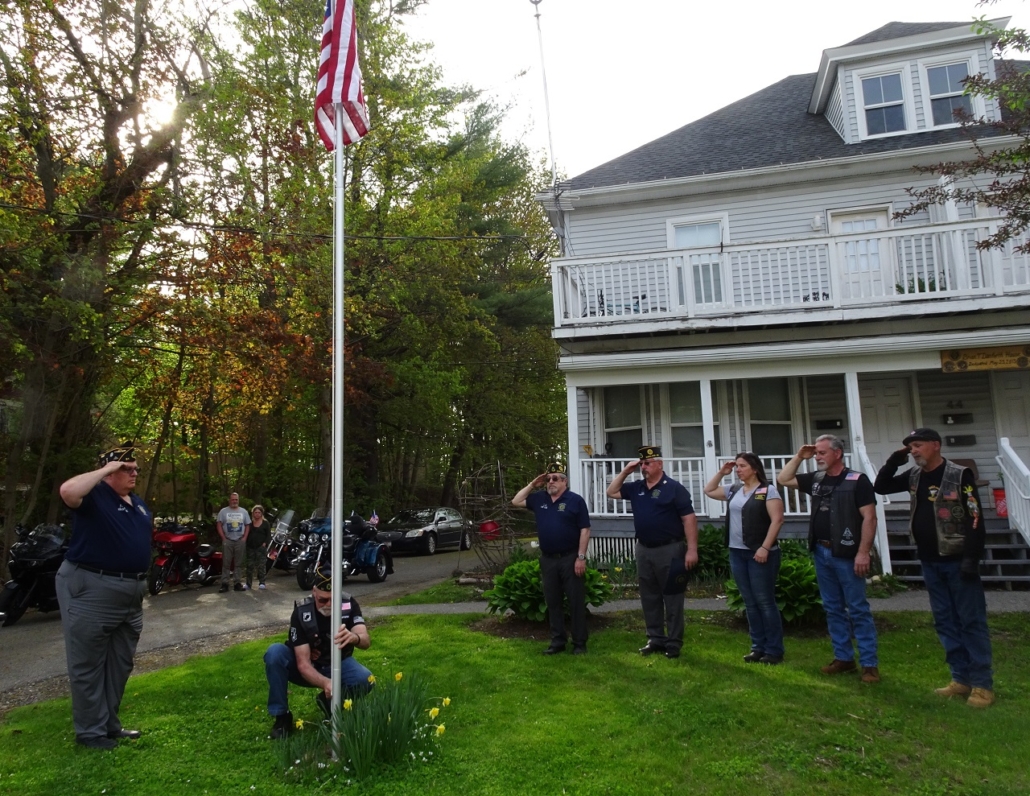
On May 14, members of American Legion Decker-Simmons Post #51 gathered with Legion Riders to dedicate a new flag and pole at veteran Brian Danforth’s home, on Fairfield St., in Oakland. The veterans who live there had lost their flag and pole during a windstorm this past winter. Legion Riders were notified, took action and replaced both the pole and flag. (photo by Wally McKenney)
Memorial Day observance

The rain stopped just in time for the American Legion Decker-Simmons Post #51 parade to get underway. With a ceremony to honor all who gave their lives at Lakeview Cemetery, Commander Jeffrey Flye gave a speech that was followed by the honor guard performing a rifle salute to the fallen. Left to right, Mark Spencer, Winslow VFW Commander Mike Dumont, Tina Zelberek, John Palmer, Jeff Stevens, Brian King, Colin Clifford, Jeffrey Flye, Patric Linehan, Winslow VFW Quartermaster Chris Soucy and Tom Dechaine. (photo by Wally McKenney)
Fundraiser
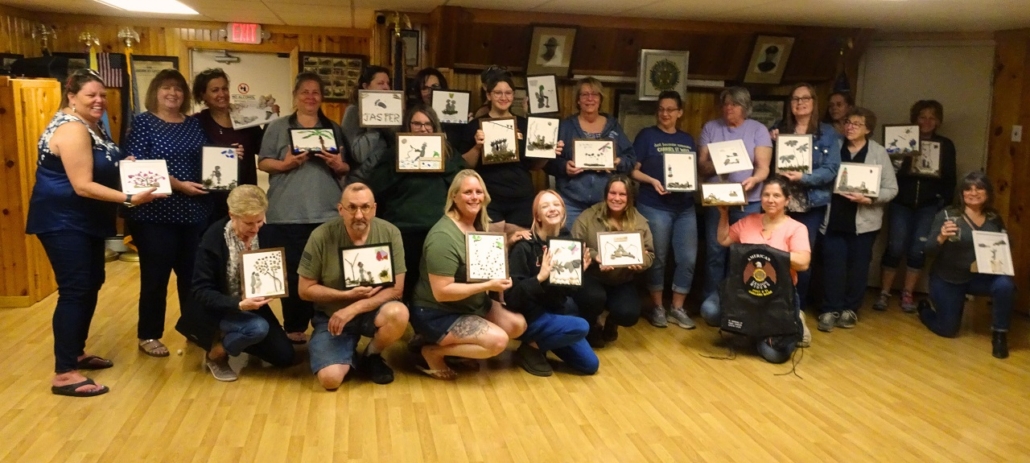
American Legion Riders of Post #51, in Oakland, recently held a fundraiser, hosting a Pebble Art class. There were 25 students who managed to raise $385 for veterans through donations and a 50/50 raffle. The members of Legion Riders were very pleased with the turnout. Overall, it was well-received, and everyone enjoyed themselves. Numerous attendees inquired about the next class, so they are looking into organizing another one soon. (photo by Wally McKenney)
Flag retirement
American Legion Decker-Simmons Post #51 Oakland, with Grover-Hinckley Post #14, held a ceremony retiring many U.S. flags. A moment of silence was observed for the 80th anniversary of the 153,000 men who lost their lives on D-Day. Above, Post #51 Commander Jeffrey Flye begins disposal process.
If anyone has a flag that is faded, tattered, or torn you can bring the flag to any American Legion Post to have it properly disposed.
Oakland Memorial Day parade and ceremony go on despite rain (2024)
/0 Comments/in Community, Events, Holidays, Oakland/by Mark Huardby Mark Huard
For the past three years since the pandemic, the Oakland American Legion Post #51 has directed the Annual Memorial Day parade which is one of the largest in Central Maine. Veterans lined the front of the parade to local school bands, classic cars, military vehicles, Police and Fire departments, Shriners and among many others. Each year they are looking for more to participate. Any groups are encouraged to contact the post for next year’s attendance.
The Kora Drifters are a parade unit of the Kora Shrine, in Lewiston. The Drifters were started by Bernie Fortin, of Vassalboro, in 2018, and have since expanded to 14 members. They raise funds for the Shriners hospitals, in Massachusetts, and all money raised goes to those charities. Any other expenses they pay out-of-pocket. They are known for their distinctive bright green colors and love to entertain. The Shriners are currently scheduled to parade in 27 different events this year, to include Maine’s largest festivals such as the Clam Festival, the Moxie Festival, and the Lobster Festival. Really what you have is 14 guys dedicated to supporting child patients at the hospitals. With the added bonus of making people happy at the same time. On Memorial Day they participated in parades in Oakland, Skowhegan, and Old Orchard Beach.
MY POINT OF VIEW: The origin and history of Memorial Day
/0 Comments/in Holidays, My Point of View/by Gary Kennedy
A close-up view of a tombstone at the Arlington National Cemetery, marking the grave site of four unknown crewmen assigned to the battleship USS MAINE (BB 2). The Marine sank after exploding off the coast of Havana, Cuba, killing approximately 260 crewmen. The sabotaging of the main precipatated the American declaration of war against Spain in 1898.
 by Gary Kennedy
by Gary Kennedy
Originally this date in time was named Decoration Day. A day of remembrance of those who died in service to our country. It was originally commemorated on May 30, 1868. It was to show our respect to those who gave their lives in the Civil War. This proclamation was given by General John A. Logan, of the Grand Army of this Republic, an organization of Union sailors and soldiers at Arlington National Cemetery, in Washington, DC.
During the first national event former Union General and sitting Ohio Congressman James Garfield was the primary speaker. There were 5,000 volunteers that opted to help decorate the final resting places of more than 20,000 Union and Confederate soldiers. It was here that the recognition of the fallen was realized and addressed. Other observances followed suit, however, the events held by the freed slaves was for the Union troops for obvious reasons. These were held in and around Charleston, South Carolina, for the most part.
New York was the first state to make this a legal holiday and at this point in time the holiday was addressed as Memorial Day. This all occurred in 1873. By the late 1800s many states had adopted this holiday and made it a state holiday after World War I. The holiday was considered a holiday for all who fell in battle while serving their country. Eventually, in 1971, Congress passed the Uniform Monday Act which designated Memorial Day would be celebrated on the last Monday of May. That has held to this very day.
Many people, over time, have questioned what they consider the similarity between Memorial Day and Veterans Day. However, similar, they are very different. The intention of the Memorial Day holiday was/is to honor all service personnel who died during armed conflict. The Veterans Day holiday is to honor all veterans who have served our country with honor dead or alive.
In December 2000 the US Congress passed and signed into law, “The National Moment of Remembrance Act”. (P.L. 106-599), creating the thought of the people of the USA, the National Moment of Remembrance. This moment begins at 1:11 p.m., eastern time thus progressing one hour for each time zone. The thought here is for total silence for two minutes in remembrance and thanks. In 1971 Memorial Day was declared a national holiday by an act of Congress. At this time it was officially placed in the last Monday in May for observance.
This is the time we see thousands of flags and beautiful flowers. For many this is a sad time, a time to mourn. For those who have lost no one it’s a time for respect and thankfulness for their sacrifice. It was also at this time that Colonel John McCrae wrote the beautiful poem, In Flanders Fields, which led to the Poppies of that battle field to become the holiday’s treasured flower. I won’t write that poem here as you can pull it up on your computer. Moina Michael, a YMCA worker, inspired wearing the poppy by adorning one and giving many others away.
There are several “Do’s and Don’ts” relating to Memorial Day that I should mention. 1) Don’t say “Happy Memorial Day”, you can express your gratitude to all men and women who have served and we are proud to honor them. 2) Don’t thank current troops; you should avoid saying, “Thank you for your service”. 3) Don’t let politics keep you from rendering respect; we have been defended for more than two centuries. 4) Don’t let business greed be part of who you are on this day. Memorial Day is prideful but on its face not a happy occasion. You can wear a memorial button from May 1 until Memorial Day. The not wearing of white was a southern thing mostly because of the heat. It really doesn’t apply anymore. Just be tasteful to the event you are attending. Like all three-day weekends from work enjoy your family and friends; a prayer for those who gave it all is respectful and appropriate and it should come from your heart. God bless and have a happy and safe weekend. I will talk to veterans next week.
Honoring the new mother
/0 Comments/in Community, Holidays/by Gillian Lalimeby Gillian Lalime
A simple yet profound fact of life is that we each owe our lives to mothers. Perhaps this goes without saying but it also extends past the obvious recognition. If you have cream in your morning coffee, it is a mother cow who gave that cream. If you eat eggs it is mother hens who lay those eggs. In languages worldwide the Earth itself is a feminine term, recognizing implicitly that all beings come from Mother Earth. It is said there is nothing so powerful as a mother’s love for her children.
To begin, a mother must first give her own body to create that of her baby’s. The new mother will grow an additional organ to support the developing baby, which could otherwise be registered by her body as a foreign invader since it has different DNA. A baby is first protected and nourished by the placenta while in utero. Just as a mother delivers a baby, she must also deliver the placenta. Many cultures have traditions that recognize and honor the placenta. In ancient Hawai’i the placenta was buried alongside deceased ancestors and was said to have its own spirit. The Maori, of New Zealand, have the same word for ‘land’ and ‘placenta’ and also bury their placenta to establish the first connection between baby and Mother Earth.
Nowadays, just shy of 99 percent of babies are born in a hospital. During this process a vast majority of placentas are swept away and either disposed of or sold. Because of this practice placentas are largely unrecognized for their crucial role as the physical link between Mother and Baby during pregnancy. When the umbilical cord is cut it is not the connection between human mother and baby which is lost but rather, it is a separation between the baby and placenta. Therefore the name ‘First Mother’ is given to this organ by some midwives birthworkers.
To recognize the metamorphosis that is the shift from Maiden to Mother, the Diné, or Navajo Nation, has a Mother’s Blessing ceremony. The Mother’s Blessing is different from a baby shower in that it focuses on honoring and celebrating the woman about to give birth rather than the baby soon to arrive. It is a sacred coming together of women which honors the physical, mental, emotional, and spiritual transformation about to take place. When a baby is born, so too, is a Mother.
One way of estimating a society’s value of mothers could be measured through how a new mother is supported during their maternity leave. Here in the United States the average maternity leave for working moms is around ten weeks, largely unpaid. Out of that time around ten days are covered by built-up sick leave while another 12 days are covered by paid time off. Maine has an average of ten weeks unpaid maternity leave. How does this compare to other societies? A book called The Fourth Trimester examines postpartum care across the globe.
In China traditions rule that soon-to-birth women are not even allowed to stay in their own homes. Their removal ensures new moms will not participate in day-to-day household chores. They are instructed by aunties, sisters, and grandmothers to hold a period of Zou yue zi or “sitting in” for the acute postpartum time, where they are waited on by surrounding women.
In India the first five to seven weeks postpartum is referred to as the ‘Sacred Window’. Apparently the saying goes “fifteen days in the bed, fifteen days on the bed, fifteen days near the bed”. Traditions such as drinking only warm liquids like teas and broth, eating soft, easily-digestible soups, and resting the eyes are all prescriptions for a new mother, whose body is in a state of repair and needs deep rest and nourishment.
In Mexico a ‘Closing of the Bones’ ceremony takes place 40 days postpartum. Women are often supported in gently massaging and wrapping their bellies to increase repair and support the organs in returning to normal positioning after almost ten months of pregnancy.
In each of these traditions it takes a minimum of 40 days for the female body to reconfigure rest and recover from the enormous task of pregnancy, labor, and birth. The Sacred Window also recognizes and honors the bond that happens between mother and baby, or the mother-baby dyad. The days and weeks immediately following birth are a time for the new baby to adjust and integrate into a world of bright light, loud sound, and gravity. It is a tender time for both mother and baby and as such – should not be rushed. Recommendations from traditions worldwide during this ‘fourth trimester’ period are: Rest, Nourishment, Warmth, Connection, Bodywork, and Nature.
With this knowledge a question arises: What can we do to actively recognize, honor, witness, and thank the mothers in our lives?
Maybe we cook them a nourishing meal. Perhaps we let them sleep in or take a nap, go for a walk in nature or sit quietly with a book. We might offer to brew a cup of tea or give them a massage. Maybe all a mother wants is an hour of quiet time to do whatever she pleases or nothing at all. It might be lending a hand in the garden or yard. Maybe it’s doing the dishes or cleaning the bathroom. And, of course, each day we can be grateful for all that a mother gives.
Article Information Sources:
Photo: https://seekingheavenlymother.com/wp-content/uploads/2020/05/mother-earth.jpg
Paragraph 2: https://parentsguidecordblood.org/en/news/honoring-placenta-different-cultures
Paragraph 3: https://www.ncbi.nlm.nih.ov/sites/books/NBK555484/
Paragraph 5: ZerotoThree.org, Annuity.org,
Another successful year at Kringleville
/0 Comments/in Community, Events, Holidays, Waterville/by Website Editor Throughout December, Downtown Waterville welcomed over 2000 families who gathered to meet Santa in his Kringleville cabin. Over 700 cups of hot chocolate with cookies and other baked goods were served, and 1200 candy canes and over 1000 books were given to children. Kids also had the chance to see snowmobiles, tow trucks, Jeeps, Elves, and Elsa; They could decorate ornament crafts, listen to a DJ, learn from the Children’s Discovery Museum mobile exhibits, engage in coloring activities, or choose a bookmark for their new book. Santa’s sleigh even made an appearance to transport Santa to and from the North Pole. They also served as a collection site for the Maine Children’s Home’s Holiday Program and filled an SUV with donations.
Throughout December, Downtown Waterville welcomed over 2000 families who gathered to meet Santa in his Kringleville cabin. Over 700 cups of hot chocolate with cookies and other baked goods were served, and 1200 candy canes and over 1000 books were given to children. Kids also had the chance to see snowmobiles, tow trucks, Jeeps, Elves, and Elsa; They could decorate ornament crafts, listen to a DJ, learn from the Children’s Discovery Museum mobile exhibits, engage in coloring activities, or choose a bookmark for their new book. Santa’s sleigh even made an appearance to transport Santa to and from the North Pole. They also served as a collection site for the Maine Children’s Home’s Holiday Program and filled an SUV with donations.
This amazing free event could not happen without Santa’s right-hand elf Jake. Jake the elf spends the rest of the year as Rick Bryant, a dedicated board member of the museum and Christmas-spirit keeper. He organizes all of the big man’s meetings, maintains the cozy cabin, secures financing and donations, and much much more. A huge thank you to him and all that he does for Kringleville!


